Device for splinting a cavity, organ duct and/or vessel
a technology for organs and splints, which is applied in the field of splinting devices for cavities, organ ducts and/or vessels, can solve the problems of serious illness risk, increased risk of snoring, and inability to register serious health risks, and achieves good physical tolerance, adapted flexibly, and avoid irritation of the pharynx and nausea.
- Summary
- Abstract
- Description
- Claims
- Application Information
AI Technical Summary
Benefits of technology
Problems solved by technology
Method used
Image
Examples
Embodiment Construction
[0033]FIG. 1 shows the nasal chamber (1), the hard palate (2), the trachea (3), the soft palate (4), the oral cavity (5), the free airways (6) and the tongue (7). Illustrated is the free airway during sleep of a healthy person. FIG. 2 shows the closed airway (8) in the pharynx, as occurs in obstructive sleep apnea. FIG. 3 shows the use of the n-CPAP breathing apparatus with the breathing mask (9) in place, and the air passages opened by the overpressure.
[0034]FIG. 4 shows a view of the components of a first embodiment of a device according to the invention for the splinting and / or holding open of a cavity, organ duct and / or vessel in a human or animal body. The device comprises a three-phase stent (10), connected at its proximal end (21) via a connecting element (11) to the connecting element (12) of a pulling element (13). To insert the stent into the cavity, organ duct and / or vessel, the stent is inserted into the tube (14) and compressed. At its proximal end (21), the stent (10) ...
PUM
| Property | Measurement | Unit |
|---|---|---|
| length | aaaaa | aaaaa |
| length | aaaaa | aaaaa |
| length | aaaaa | aaaaa |
Abstract
Description
Claims
Application Information
 Login to View More
Login to View More - R&D
- Intellectual Property
- Life Sciences
- Materials
- Tech Scout
- Unparalleled Data Quality
- Higher Quality Content
- 60% Fewer Hallucinations
Browse by: Latest US Patents, China's latest patents, Technical Efficacy Thesaurus, Application Domain, Technology Topic, Popular Technical Reports.
© 2025 PatSnap. All rights reserved.Legal|Privacy policy|Modern Slavery Act Transparency Statement|Sitemap|About US| Contact US: help@patsnap.com



